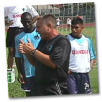Sprint Mechanics
I wish it were as simple as dead lifting more weight. Improving maximal strength is one factor, not the only factor. Anyone who is trying to make someone faster knows that that ultimately it is about where the rubber meets the road, ground contact. The goal is very simple, put more force into the ground in a shorter amount of time. Strength is a key factor, but there are a multitude of other supporting factors. I do not want to try to oversimplify this, but to make this complicated is also a mistake. There is no doubt that getting someone stronger in terms of maximum strength will make one faster, especially at younger training ages, but my experience has shown that you soon reach the point of diminishing returns. More time in the weight room will NOT result in more improvement; it must be coupled with sound overall approach. Running mechanics must be trained. They must be trained to take advantage of the body’s natural reflexes, the stumble reflex and the cross extensor reflex. Technique training should not be mechanical and cognitive, rather it should tune into the wisdom of the body to improve body awareness and posture to help improve efficiency. When I look at the sprint, I look at four zones: 1) Starting 2) Acceleration 3) Top Speed 4) Finishing. Each zone has different technical requirements that must be addressed. Supporting those technical factors are various approaches to strength and power development to enhance each of the zones. A major goal of technical training is to link those zones into a seamless whole that rhythmically flows into the unified whole, the 100 meter sprint. In order to do that I use a systematic approach that I have evolved over the past twenty-five years – The PAL Paradigm. (For a detailed explanation see our book Sport Specific Speed - The 3 System) PAL is an acronym for posture, arm action
 and leg action. All technique work is based on this paradigm. Rather that breaking the sprint stride into too many parts the PAL paradigm focuses on larger movements that are natural and take advantage of the wisdom of the body. Gerard Mach, former National Coach of Canada, has been a big influence on my thinking in the evolution of this system. Most of his drills are NOT technique drills; they are drills to develop specific strength. My interpretation of Bosch and Klomps drills is the same. I am relatively sure that they are not designed as technique drills. Every time you sprint you should be working on technique. Underlying technique is rhythm and relaxation. Everything must be done in a smooth flowing manner. The key is to work on mechanics without being mechanical.
and leg action. All technique work is based on this paradigm. Rather that breaking the sprint stride into too many parts the PAL paradigm focuses on larger movements that are natural and take advantage of the wisdom of the body. Gerard Mach, former National Coach of Canada, has been a big influence on my thinking in the evolution of this system. Most of his drills are NOT technique drills; they are drills to develop specific strength. My interpretation of Bosch and Klomps drills is the same. I am relatively sure that they are not designed as technique drills. Every time you sprint you should be working on technique. Underlying technique is rhythm and relaxation. Everything must be done in a smooth flowing manner. The key is to work on mechanics without being mechanical.

3 Comments:
I am a triathlon coach in the UK, and I follow the Supertraining threads on run and the Weyand study with trepidation, because I work a lot on technique when I coach running. Admittedly I coach endurance running, not sprinting, but I would hate to think my efforts are scientifically unsound, that technique is not worth coaching. When you see a distance runner or triathlete running with their arse in a bucket, jumping from heel to heel at a cadence of 80, then I think technically there are things to address
huw- Did you read the BK book? They dismiss the low hips style of running as a normal anomaly, and give a biomechanical explaination. Your thoughts please.
Vern-
I'm in full agreement and thought your readers might be interested in a recent article I've written on the topic at hand.
Post a Comment
<< Home